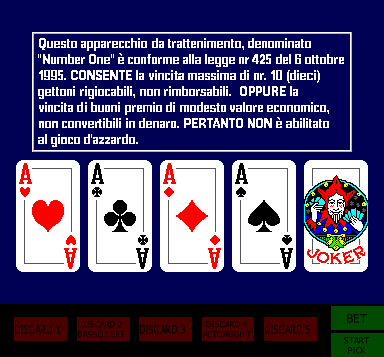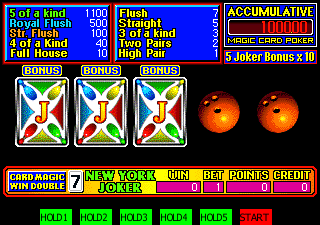Robbie has been working on a driver for the San Remo gambling game that was dumped earlier, but he hit a snag and couldn’t figure out how the graphic banking worked. He mentioned partial video updates in his latest update but based on his description of the problem I had a hunch it was something else and offered to take a quick look at it.
It turned out my hunch was right, so I ended up fixing the graphics there for him, only took about 5 minutes because it’s actually very simple. The hardware automatically writes previously latched bank bits for the upper tile bits whenever a tile is written (basically a primitive hardware tilemap accelerator so that 16-bit data can be written with only the cost of a 8-bit writes) Subsino used the same technique for several of their games, as did Mole Attack from Yachiyo so previous exposure to those drivers meant it was something I thought likely from the explanation Robbie gave.




I also look at another recent dump which turned out to be a gambler on the High Video platform called New York Joker, in this case Robbie is going to fix up the inputs and lamp outputs etc. so that I can concentrate on other things instead.


A version of Playmark’s redemption game ‘Lucky Boom’ also showed up on a different hardware configuration and should help clean up some code in that driver too once it’s been looked at a bit more.
Mundane games, yes, but they show there is a story behind most additions and the working process.
You should take a look into the UK MPU4 BWB video fruit machines if you like a challenge :)
J
Great work by the way :)
Do gambling machines tend to have more complex video systems than arcade hardware for normal non-gambling games? I know that there will tend to be more devices (reels, levers, buttons, lights, and more) that need to be driven, spun, interrupts acknowledged, etc…..and reading Roberto’s page a lot (his posts are really interesting) I see a lot of strange things like “intensity layers”, encrypted graphics, graphics operations with PLDs……does all of that usually happen in gambling games?
I wouldn’t really say that was the case.
Sometimes they have slightly odd ways of drawing reels etc. but for the most part they’re pretty simple, not even usually having any sprites.
There are more annoying ones, like the MPU4 mentioned above which is annoying because it’s an extension to the base fruit machine hardware and is loaded with devices for timing, communications and all that, in addition to protection chips which scramble the questions. I’m not sure why Crystal Maze for example runs the inputs in slow motion.
but these ‘throw away’ hardwares tend to be quite basic this one we have here (San Remo) is just a single fixed (non-scrolling) 4bpp tilemap with fixed RGBI colours (no palette ram) driven by a single CPU with a simple sound chip.
I guess the technical details get mentioned more with games like this because it’s about the only interesting thing you can write about them ;-)
I think for some of the ones Robbie has worked on they have expanded on older base games and therefore ended up with obscure banking schemes to pack it all in, and yeah encryption is used sometimes, plus MCUs, but it’s nothing really significant / weighted towards the gamblers IMHO.
Some of the more recent ones are interesting for their use of all in one SoC chips, or modern versions of CPUs with built in peripherals (a whole bunch of non-working touch screen ones use the Coldfire and expect the extra features of it to work, unlike FunCube)
but some of the actual most basic pieces of hardware you’re going to find anywhere are gamblers, and are actually good easy ‘first targets’ if somebody wants to try understanding an emulator.
Thanks for the reply. The games themselves may be uninteresting, but the little technical details on how things work are always interesting to me, seeing how the designers dealt and worked around such limited hardware. Being a device programmer kinda makes you appreciate every individual byte write because they always count when you work close to hardware :P.
The last time I’ve been to a casino (fancy hotel in Puerto Rico 6 years ago)….yeah, the machines are very fancy compared to the old stuff that usually gets posted about in MAME, linked machines, giant roulette setups with electronic table, physical spinner, and a display and sound to boot….they’ve got to be really complex setups under the hood.
yeah, for the bigger ones it was often a case of ‘cost doesn’t matter’ you see that even with the older Sega ones for which we still don’t have a complete setup dumped. I briefly touched on this in the ‘disappointments’ section of the 2012 article, showing the screenshot of Royal Ascot as an example.
If you look at http://www.system16.com/hardware.php?id=840 you’ll see lots of examples of this kind of thing, and typically every single individual screen is a complete PCB with encrypted CPU, and the main screen is another setup, then there are additional ones for sounds and mechanical parts etc.
I guess because they make so much money the cost of them is a bit of a non-issue, although I’m surprised reliability didn’t suffer and the last thing you want if you’re operating these things is downtime.
For every high-budget game there were likely hundreds of cheap ones, and in places like Italy those ones just seem to have ended up in public hands after various legislation changes banning different incarnations of them, that’s why you see quite a lot of them emulated.
A fair number of the ones in that category did use secure MCUs as the only CPU tho, so they can’t actually be emulated without some way to decap, unprotect and read them.
“The games themselves may be uninteresting” . uninteresting to most probably but i have as many good memory’s playing gamblers as i do arcade games. Used to be a toss up with my last 10p between Solomon’s key or a few hands at noraut poker to see if i could win a bit more and stay longer.
Always interested to see what pops up on Robbie’s page.
yep, everybody is going to have different memories of things.
some people say I’m crazy for insisting that MESS properly document both original games and the cracked versions for example, because most people don’t see the value in the cracked ones when the originals are emulated but I feel they still have a place in history and in the minds of many people.
one of the best things MAME has managed to do over the course of the last 15+ years is stay neutral, of course there have been periods where personal opinions to exclude things have come into play (the original gambling game ban) but I think as a whole we’ve seen how damaging they were. It’s an all-inclusive project, for everybody (UME even more so)
Bit OT, but I took liberty of translating the Number One’s legal disclaimer:
This entertainment device, known as “Number One” and in compliance with Law no 425 of 5 October 1995. ALLOWS the maximum payout of 10 (ten) replayable, non-refundable tokens, OR the winning vouchers of low economic value, non-redeemable for cash, and NOT authorizing [use of the device] for gambling [purposes].
I used Google Translate at first and edited the remaining by hand.